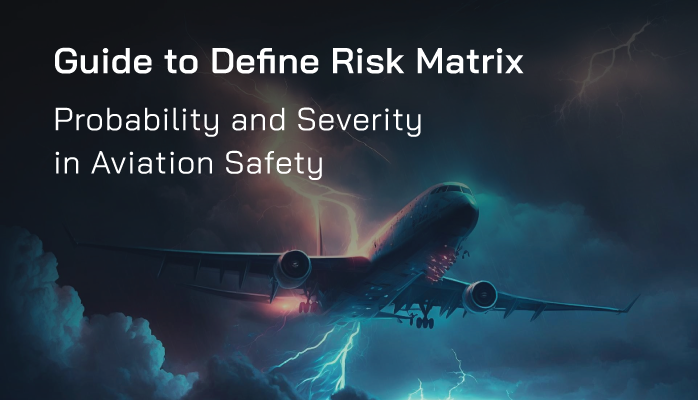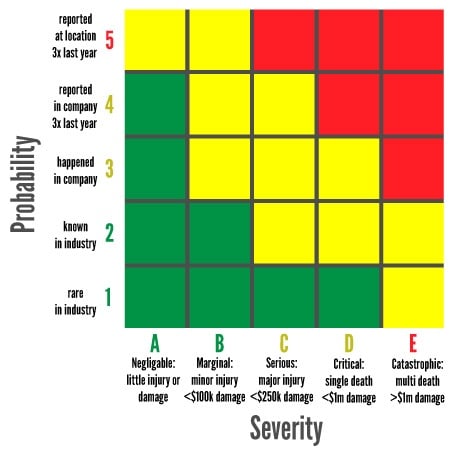Risk Matrix Probability and Severity in Aviation Safety

A risk matrix is a vital tool in aviation safety management systems (SMS), enabling organizations to assess and prioritize risks by combining their probability and severity. This guide outlines how aviation safety managers can define these criteria to create an effective, organization-specific risk matrix.
Understanding Probability
Definition
Probability is the likelihood of a hazard resulting in an adverse event. It is typically categorized into levels like Frequent, Occasional, Remote, Improbable, and Extremely Improbable.
Defining Criteria
- Quantitative: Use historical data (e.g., incidents per flight hour). Example: “Frequent” as >10 incidents/year.
- Qualitative: Use descriptive terms (e.g., “likely to occur sometimes”) when data is limited.
- Local Factors: In Alaska, weather-related risks may have higher probabilities due to frequent storms.
Steps
- Analyze incident reports and industry benchmarks.
- Consult pilots and safety officers for expert input.
- Document clear definitions (e.g., “Remote: 1 occurrence in 5 years”).
Related Risk Matrix Articles for Aviation SMS
- What Is a Risk Matrix and Risk Assessment in Aviation SMS
- How to Create Your Risk Matrix for Risk Assessments in Aviation SMS
- 5 Questions to Ask Before Making Risk Assessment
Understanding Severity
Definition
Severity measures the potential impact of a hazard, considering safety, financial, environmental, or operational consequences.
Defining Criteria
- Categories: Include personnel injury, financial loss, environmental damage, reputation and operational disruption.
- Thresholds: Example: “Catastrophic” as multiple fatalities or >$10 million loss.
- Context: Remote areas may escalate severity due to delayed emergency response.
Steps
- Identify relevant consequence categories.
- Set specific outcomes for each level (e.g., “Minor: First aid required”).
- Combine categories, using the highest severity.
Customizing the Risk Matrix

- Scope: Define which risks to cover (e.g., safety, operational).
- Levels: Start with a 5x5 grid (probability 1-5, severity A-E).
- Matrix: Assign risk levels (low, medium, high) and colors (green, yellow, red).
- Acceptance: Specify actions (e.g., mitigate red risks immediately).
- Validation: Test with past incidents and adjust.
- Stakeholders: Involve operational teams for relevance.
- Training: Document and train staff on matrix use.
Examples
Alaskan Air Taxi
- Risk: Marginal weather flight.
- Probability: Occasional (4, 1-5 incidents/year).
- Severity: Hazardous (B, serious injury risk).
- Action: Implement stricter weather minimums (red zone, 4B).
Large Airline
- Risk: Engine failure.
- Probability: Remote (3, rare occurrences).
- Severity: Major (C, significant safety reduction).
- Action: Enhance maintenance protocols (yellow zone, 3C).
Related Articles on Aviation Risk Management
- Difference Between Reactive, Predictive and Proactive Risk Management in Aviation SMS
- From Reactive to Proactive Risk Management in Aviation SMS
- How to Practice Reactive, Proactive, and Predictive Risk Management in Your SMS
Best Practices
- Use clear, measurable criteria.
- Base definitions on data and expert input.
- Review and update regularly.
- Integrate with SMS processes.
- Train staff for consistent use.
Common Pitfalls
- Using generic criteria.
- Ignoring stakeholder input.
- Failing to update the matrix.
- Overcomplicating definitions.
- Neglecting training.
Conclusion
A tailored risk matrix enhances aviation safety by providing a clear framework for risk assessment. By defining probability and severity thoughtfully, safety managers can ensure their matrix drives effective decision-making and fosters a proactive safety culture.
SMS Pro Administrators have the ability to customize their risk matrices without requiring technical help, yet we're here to help when needed. Need help with your risk matrix?






